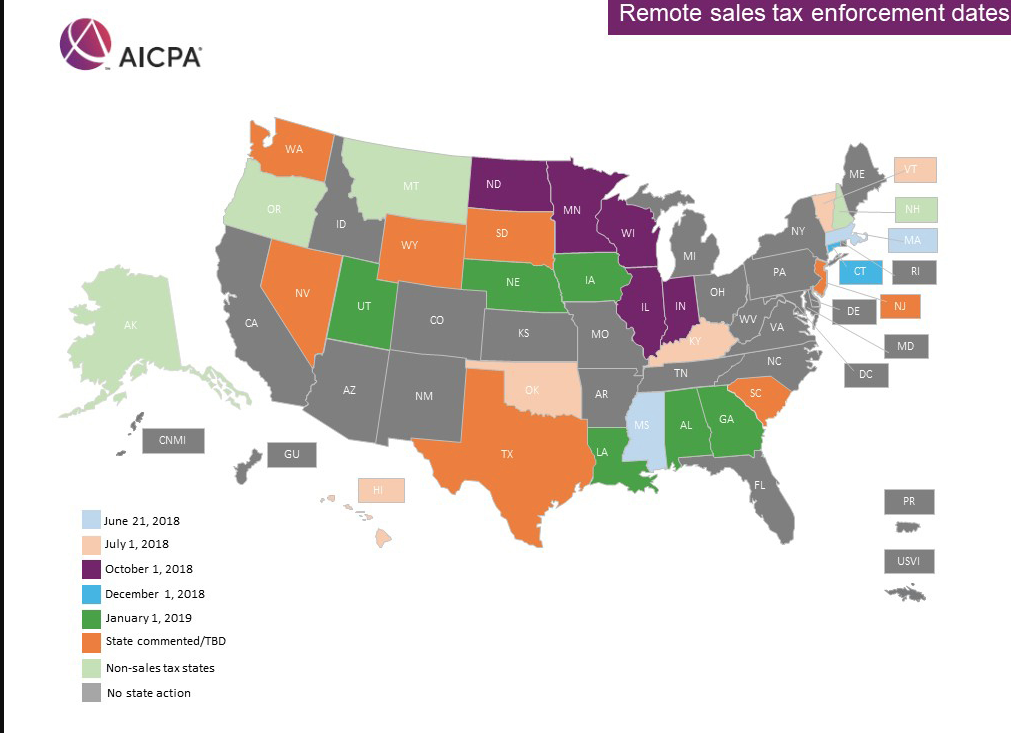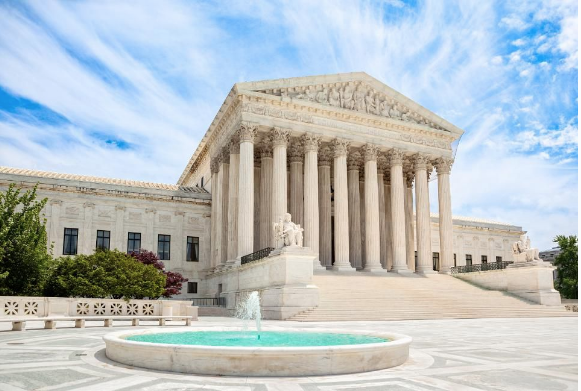No posts were found.

Sales Tax Update
South Dakota v. Wayfair
Background
On June 21, The United States Supreme Court ruled 5-4 in South Dakota v. Wayfair that states can mandate that businesses without a physical presence in a state with more than 200 transactions or $100,000 in-state sales collect and remit sales taxes on transactions in the state. This decision overturned the Court’s 1992 decision in Quill v. North Dakota and 1967 decision in National Bellas Hess. Since the decision was handed down by the Court, states and retailers alike have been asking “What’s next?”
According to the Court’s majority opinion, the South Dakota law did not have an unreasonable burden on retailers because of the following:
- It is not retroactive, meaning South Dakota can’t look back and require collection and remittance of sales and use tax on previously purchased items.
- Only merchants who have considerable amount of business are required to collect (according to the South Dakota law in question that means $100,000 in in-state sales or over 200 orders in the state).
- South Dakota is one of 20 states that have adopted the Streamlined Sales and Use Tax Agreement, which provides certain standardization within the sales and use tax statutes “to reduce administrative and compliance costs” for remote sellers.
Federal outlook post Wayfair
The debate on taxing internet sales arose after the 1967 Supreme Court decision in National Bellas Hess v. Illinois Department of Revenue, which set the physical presence standard for collecting sales tax on out-of-state purchases. In 1992, the Court affirmed the Bella Hess decision and directly stated that Congress is better suited to address this issue and has the “ultimate power to resolve” it. More than a quarter of a century later, Congress has been unable to change or overrule the physical-presence standard, but it was not for a lack of trying.
Despite widespread support from most states and a diverse coalition of small and large retailers for the Marketplace Fairness Act (MFA) and the Remote Transactions Parity Act (RTPA), congressional efforts to address the issue remained elusive. As a result, hopes of any change rested upon states’ efforts to challenge Quill, which were successful in the Wayfair case. Now that Quill has been overturned, questions on whether there remains a need for MFA, RTPA or other similar proposals to create a federal standard is a subject of debate among policymakers and businesses. The fallout from Wayfair continues as congressional efforts to respond to Wayfair have progressed.
(2018, June). South Dakota v. Wayfair. Retrieved from https://www.aicpa.org/advocacy/state/south-dakota-v-wayfair.html.


Supreme Court’s Quill And Wayfair Cases Explained
Last week, the Supreme Court decided the historic Wayfair case, which will have cascading consequences for the online retail and e-commerce industries. Wayfair upends the Quill decision, which was decided about 25 years ago. This decision will basically affect everyone that shops online (and those retailers, too).
The issue, of course, is whether online retailers have to collect sales (or use) tax for online purchases. We all know how this works at brick-and-mortar shops: On your sales receipt, state (and maybe local) sales tax is added to your bill, collected by the merchant, and the merchant eventually pays that over to the State. For a long time, though, depending on where you did your online shopping (and where that retailer was located), you may not have seen that same sales tax line on your receipt.
At its basic level, the issue requires an explanation of a handful of cases and two constitutional issues—the Due Process Clause and the Commerce Clause. This post will focus on the two prominent cases: Quill and Wayfair.
For our purposes, let’s start with the Quill case: Quill Corp. v. North Dakota, 504 U.S. 298 (1992). In Quill, the State (here, North Dakota) was trying to collect the tax on an out-of-state mail-order retailer. Specifically, Quill was a Delaware corporation, with office or warehouses in Illinois, California, and Georgia. It sold office equipment and supplies through catalogs, flyers, and phone calls. None of its employees even worked or lived in North Dakota.
At issue, North Dakota, similar to its sales tax, imposed a use tax on property purchased for storage, use, or consumption in the state. As relevant here, it basically imposed the collection obligation on every retailer that made regular or systematic solicitations in the state, which was defined to include three of more advertisements in a 12-month period.
For its part, Quill argued that North Dakota had no power to make it collect the tax.
In Quill, there were two competing legal theories: the Due Process Clause and the Commerce Clause.
As the Court explained, “[t]he Due Process Clause ‘requires some definite link, some minimum connection, between a state and the person, property or transaction it seeks to tax, and that the ‘income attributed to the State for tax purposes must be rationally related to ‘values connected with the taxing State.’” (citations omitted)
From a historic perspective—and supported by a case called Bellas Hess—some form of physical presence was required to satisfy the due process requirements.
The Quill Court, even though prior precedent emphasized physical presence, stated that “to the extent that our decisions have indicated that the Due Process Clause requires physical presence in a State for the imposition of duty to collect a use tax, we overrule those holdings as superseded by developments in the law of due process.”
So, the Court made clear in Quill that perhaps physical presence wasn’t needed for due process concerns—so long as the retailer purposefully directed its activities at residents of the state and the magnitude of those contacts and activities was large enough.
Think of it this way: Due Process is concerned with whether the person’s activities with a State are substantial enough to justify the State’s exercise of jurisdiction or power over him. It is, at bottom, a fairness concern.
But, next was the Commerce Clause analysis.
The Commerce Clause, of course, allows Congress to regulate commerce among the several States, i.e., interstate commerce. There is, though, a judicially recognized “negative sweep” to the commerce clause, often referred to as the “dormant Commerce Clause” or the “negative Commerce Clause.” In effect, under the dormant Commerce Clause, states cannot take actions that unduly interfere with or burden interstate commerce.
The Commerce Clause concerns are distinct from that of the due process concerns; the Commerce Clause and its negative sweep are concerned with the structure of the market and the effect of state action and regulation on the national economy.
In Quill, the Court embraced a bright-line physical presence requirement, like it did in Bellas Hess. The Court noted that, “a bright-line rule in the area of sales and use taxes also encourages settled expectations and, in doing so, fosters investment by businesses and individuals.”
So, as of 1992, the Supreme Court—through its decisions in Quill and Bellas Hess—had a bright-line rule requiring physical presence, due to the Commerce Clause, for imposing sales or use tax collection obligations on retailers.
That’s why, depending on the retailer you bought your online purchase from, you may (or may not) have had sales tax collected—it depended on whether that retailer had a physical presence in your state. (You may have had a separate individual use tax obligation, though.)
Now, it’s 2018, and time for the Wayfair case.
South Dakota—like most states—taxes retail sales of goods and services. In 2016, the state passed a law that required out-of-state sellers to collect and remit sales tax “as if the seller had a physical presence in the state.” But, this obligation on out-of-state retailers applied only if, on an annual basis, the retailer delivered more than $100,000 of goods or services or engaged in 200 or more separate transactions for delivery into the state.
Jumping to the conclusion, in Wayfair, the Supreme Court held that “Quill is flawed on its own terms.” The majority opinion, written by Justice Kennedy, advanced three reasons:
First, the physical presence rule is not a necessary interpretation of the requirement that a state tax must be “applied to an activity with a substantial nexus with the taxing State.” Second, Quill creates rather than resolves market distortions. And third, Quill imposes the sort of arbitrary, formalistic distinction that the Court’s modern Commerce Clause precedents disavow. (citation omitted)
Thus, the Court concluded that, “that the physical presence rule of Quill is unsound and incorrect.”
Chief Justice Roberts and Justices Breyer, Sotomayor, and Kagan dissented. In a nutshell, the dissent argued that Congress—not the Court—should resolve the physical presence issue.
After Wayfair, it’s a new world for online retailers. It will be interesting to see how States and retailers will adapt to the new post-Wayfair world.
The case is South Dakota v. Wayfair, Inc., No. 17-494 (U.S. June 21, 2018).
Timothy M. Todd. (2018, June 27). Supreme Court’s Quill And Wayfair Cases Explained. Retrieved from https://www.forbes.com/sites/timtodd/2018/06/27/supreme-courts-quill-and-wayfair-cases-explained/#163c5f1472a4



